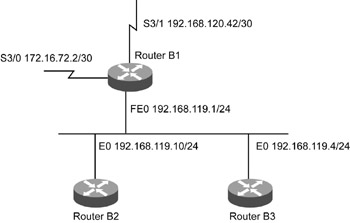Problems with Assigning Priority
The priority value is the primary parameter used in DR and BDR elections in the OSPF routing process. The priority values range between 1 and 255 with the default value as 1. If the priority values of two routers are same, the Router ID is used to determine the DR and BDR. This section discusses the problems that can arise while assigning priority values.
Consider the example depicted in Figure 9.2. This figure shows an OSPF network composed of routers B1, B2, and B3. A single broadcast-based multi-access segment is represented by the Ethernet segment.

Figure 9.2: An OSPF network.
In Figure 9.2, as per the default configuration, the interfaces FE0/0 of B1 and E0 of B2 and B3 have the priority 1. As a result, the DR and BDR election takes place comparing the Router IDs. In this example, B2 is the DR, and B3 becomes the BDR. This is shown in the output of the show ip ospf neighbor command, shown in Listing 9.11.
Listing 9.11 Output of the show ip ospf neighbor Command at B1
B1#show ip ospf neighbor Neighbor ID Pri State Dead Time Address Interface 0 192.168.119.10 1 FULL/DR 00:00:36 192.168.119.10 FastEthernet0/ 0 192.168.119.4 1 FULL/BDR 00:00:35 192.168.119.4 FastEthernet0/ 0
Let us discuss the problem that can arise in the given scenario. B1 is a Cisco 7206 Router while routers B2 and B3 are 2511 routers. It is more logical that B1 be the DR for the OSPF network. To ensure this, we need to set the interface priority accordingly by using the following commands:
B1(config)#interface FastEthernet 0/0 B1(config-if)#ip ospf priority 10
| Note | Cisco 7206 routers are more capable than Cisco 2511 routers. B1 should become the DR, because it needs to maintain adjacency with the remaining routers in the OSPF domain. |
The output of the show ip ospf interface command confirms the priority value, as shown in Listing 9.12.
Listing 9.12 Output of the show ip ospf interface Command at B1
B1#show ip ospf interface FastEthernet0/0 is up, line protocol is up Internet Address 192.168.119.1/25, Area 5 Process ID 1, Router ID 192.168.120.9, Network Type BROADCAST, Cost: 1 Transmit Delay is 1 sec, State DR, Priority 10 Designated Router (ID) 192.168.119.10, Interface address192.168.119.10 Backup Designated router (ID) 192.168.119.4, Interface address 192.168.119.4 Timer intervals configured, Hello 10, Dead 40, Wait 40, Retransmit 5 Hello due in 00:00:02 Index 20/20, flood queue length 0 Next 0x0(0)/0x0(0) Last flood scan length is 0, maximum is 37 Last flood scan time is 0 msec, maximum is 4 msec Neighbor Count is 2, Adjacent neighbor count is 2 Adjacent with neighbor 192.168.119.10 (Designated Router) Adjacent with neighbor 192.168.119.4 (Backup Designated Router) Suppress hello for 0 neighbor(s) Simple password authentication enabled
Listing 9.12 shows a part of the command output generated. The priority value is 10. B1 is elected as the DR.
| Note | The priority should be set to 0 to elect a router as the DR or BDR. |
EAN: 2147483647
Pages: 130